1.
In the early days of the Gaza war that took the lives of some 2,100 Palestinians and seventy-two Israelis, a number of officials in Washington, Ramallah, and Jerusalem began to speak of renewing Israeli–Palestinian negotiations mediated by the United States. As the fighting dragged on, this talk intensified, again showing that the “peace process” gains greatest urgency from the threat of Israeli–Palestinian violence.
There is little reason to believe that renewed talks would succeed. The obstacles that caused the failure of the negotiations led by Secretary of State John Kerry have not disappeared. Many of them have grown larger. Palestinian President Mahmoud Abbas and his political program of nonviolence and negotiation have been weakened by Hamas’s strategy in Gaza, which impressed many Palestinians, although the costs were enormous. Hamas sent thousands of rockets into Israel, killing seven civilians, while Israeli air strikes and artillery killed hundreds of children, devastated large parts of Gaza, and left tens of thousands of people homeless. Reconstruction will cost many billions and take years.
Still, Hamas demonstrated that its militancy and its willingness to endure a ferocious Israeli attack could achieve more in weeks than Abbas’s talks have achieved in years. During the Gaza war, Israel did not announce a single new settlement in the West Bank. Although Israel did not agree to some of Hamas’s most important requests—for example, the opening of a seaport and the release of recently arrested prisoners—it showed eagerness to negotiate with the Palestinians and willingness to make significant concessions, including the easing of some border crossings, extending fishing rights, and facilitating the supply of construction materials.
Palestinians in the West Bank and Jerusalem, who had been relatively quiescent in the years preceding the Gaza war, put new pressure on Israel through nightly protests and clashes that led to the largest number of arrests in Jerusalem since the second intifada. Israeli commentators questioned old assumptions about the sustainability of the status quo. The war brought a surge in international support for the Palestinians, unusually heavy American pressure on Israel to stop bombing civilians, and significant rifts in Israel’s right-wing coalition. The Ramallah leadership under Abbas seemed less relevant than ever, while Hamas’s popularity rose.
Before the war, Abbas’s price for restarting talks had been too high for the Israeli government. He wanted a freeze in settlement construction and the release of the last remaining prisoners arrested before the 1993 Oslo accords, including fourteen Palestinian citizens of Israel. Today, after losing ground to Hamas, Abbas can ill afford to abandon these demands.
The positions of Israeli Prime Minister Benjamin Netanyahu, too, have hardened. Though in recent years he appears to have conceded that the increasing population of Palestinians necessitates partitioning the territory of mandatory Palestine, Netanyahu has not fully accepted the principle of Palestinian sovereignty. During the first days of the Gaza war, he said that “there cannot be a situation, under any agreement, in which we relinquish security control of the territory west of the River Jordan,” which is to say, all of the West Bank. Following heavy criticism from his center-right constituency for having failed to achieve his objective of severely weakening Hamas and for having made concessions to it in the cease-fire agreement, Netanyahu will find it difficult to concede on prisoners or settlement construction merely for the opportunity to enter talks.
Yet these reasons may not be sufficient to deter efforts to restart negotiations. A decent chance of success has never been a prerequisite for US-led talks. The peace process offers its own rewards, quite independent of its ostensible purpose. After the many strains in its external relations caused by the destruction in Gaza, Israel will view new talks as a means to improve relations with the US, as well as to exhibit goodwill toward those Palestinians still in favor of negotiations, repair its image in the world, slow the spread in Europe of boycotts of the products of Israel’s West Bank settlements, and solidify the tacit understandings between Egypt, Jordan, Saudi Arabia, and the Palestinian Authority that gave it a freer hand in Gaza.
Those Arab governments will want new talks to demonstrate that cooperation with the US and Israel produces dividends for the Palestinians and a greater role for themselves in the peace process. The PLO leadership in Ramallah will want renewed negotiations to prove its continued relevance and show that violence is not the only means of winning concessions from Israel. Negotiations would also offer another excuse to continue yielding to Israeli and American demands that Palestine not pursue legal action against Israel at the International Criminal Court, which has been possible since it became a nonmember observer state of the UN in November 2012. (Close advisers to Abbas have stated that his threats in early September to join UN agencies and put forward a UN Security Council resolution calling for an end date to Israel’s occupation are designed to encourage new talks.) European governments will hope that negotiations provide an answer to constituents who ask why they are paying to rebuild Gaza when it is likely to be destroyed again.
Advertisement
More important, many US officials believe that new talks will help prevent greater Israeli–Palestinian conflict in Jerusalem and the West Bank. Convinced that the absence of negotiations leads to violence, they see the collapse of months of John Kerry’s efforts as one of the causes of the war in Gaza and of the turmoil in the West Bank and Jerusalem that preceded and in many respects helped precipitate it.
This reasoning has a number of flaws. It ignores the fact that in the several years preceding the Kerry talks, when there had been no negotiations, there was relative quiet in the West Bank. It assumes that Palestinians and Israelis were driven to violence by frustration and disappointment at the failure of talks from which almost none expected results. And it relies on the premise that any violence is caused either by the collapse of recent negotiations or by the fact that there was hopelessness because no negotiations had recently occurred.
Yet for most Americans who support a “peace process,” as well as for European officials, and for peace-minded Palestinians and Israelis, rising instability is almost always taken as evidence of the necessity of new talks. They are supported in this, above all, by the US secretary of state, who appears still to believe that his talents and commitment will succeed where others have failed.
2.
Even by the standard of his recent predecessors, John Kerry, who became secretary of state in February 2013, took on the Israeli–Palestinian conflict with unprecedented intensity. It was not an obvious choice, given the record of past diplomatic efforts, the many factors that had made the conflict only more difficult to resolve, and the far larger scale and importance of other challenges facing the United States: the Syrian slaughter; sectarian violence and anti-American militancy spreading throughout the Middle East; and an effort to shift US priorities to counter the rising power of China.
Despite all of these, America’s ambitious new secretary of state found it particularly urgent to resolve the more than century-old conflict between Jews and Arabs in a territory smaller than his home state of Massachusetts. Between Kerry’s swearing in and the launch of the talks half a year later, intercommunal violence claimed fewer than ten lives.
The large attention Kerry paid to the conflict was matched by the resources the US provides to Israel, which receives more American aid than any other country—over $3 billion annually, making up over half of US worldwide military aid. The Palestinian government, too, secures close to half a billion per year, and is among the largest per capita recipients of US aid. Over these two small and highly dependent clients, the US might be expected to possess considerable leverage. Yet its efforts to broker a peace agreement between them have been repeatedly frustrated, suggesting the apparent impotence of the world’s most powerful nation.
The demography of Gaza, the West Bank, and Israel—where, collectively, the number of gentiles recently surpassed that of Jews—led Kerry to assert last year that “the window for a two-state solution is shutting,” because Israel would soon face the choice between “either being an apartheid state with second-class citizens—or it ends up being a state that destroys the capacity of Israel to be a Jewish state.” When announcing the start of the negotiations in July 2013, he stated that his objective was a comprehensive peace treaty within nine months, and he maintained this goal in the face of widespread skepticism.
Yet his critics failed to understand that there was little penalty for wrongly forecasting success when the world had grown so accustomed to failure. Ahead of the July 2000 Camp David summit, President Bill Clinton said a peace agreement could be achieved in several days. At the outset of the Annapolis talks in November 2007, President George W. Bush and Secretary of State Condoleezza Rice expressed confidence that an agreement would be reached within one year. Three years later, in September 2010, President Obama and Secretary of State Hillary Clinton renewed Bush’s one-year vow as they launched talks that lasted all of three weeks.
3.
Despite the failure of past efforts, many senior US officials who have worked on the Israeli–Palestinian conflict have believed that they had a good chance of reaching a comprehensive peace agreement with each new round of negotiations. These officials—as well as the think tanks, NGOs, advocates, journalists, analysts, and former officials that seek to influence them—can be divided into three groups. Their differing approaches to policy have dominated Middle East decision-making for over two decades and contributed to the failures of each administration.
Advertisement
The first and smallest of the three groups, whom I will call Skeptics, is represented by conservatives and neoconservatives who fundamentally believe that Arabs will not make peace with Israel, or, in the more nuanced version, that Arabs will not accept peace on terms acceptable to Israel’s center-right majority. On the latter point, they are surely correct.
Prominent people and institutions associated with the Skeptical camp include senior officials of the George W. Bush administration, such as Elliott Abrams, John Bolton, and Douglas Feith; the Zionist Organization of America; the American Enterprise Institute and the Foundation for Defense of Democracies; and The Weekly Standard, Commentary, and the editorial board of The Wall Street Journal.
Because many Skeptics oppose the peace process, their influence on US-brokered negotiations has been more limited than that of other groups. Much of their suspicion of the peace process derives from their accurate assessment that past Israeli offers have fallen far short of Palestinian demands. A few Skeptics still oppose the establishment of a Palestinian state, but since the administration of George W. Bush officially endorsed the goal of creating one, their voices have been largely muted.
Skeptics tend to consider peace negotiations not simply a waste of time but dangerous, citing as evidence the second intifada that followed the failure of the July 2000 Camp David summit. They note that every significant agreement signed between Israel and its Arab neighbors—from the Oslo Accords with the PLO to the peace treaties with Egypt and Jordan—was initiated without the US. (Skeptics tend to downplay the importance of subsequent US efforts to support these agreements.) Because of their antipathy to “top-down” negotiations for a peace agreement between Israeli and Palestinian leaders, they have focused instead on “bottom-up” changes, most notably the program of the unelected former Palestinian finance minister and prime minister Salam Fayyad to build the institutions that could support an eventual Palestinian state.
The record shows that since the 1993 Oslo Accords that established limited Palestinian autonomy and self-governance, Bush administration Skeptics were responsible for many more positive, consequential changes than their predecessors and successors in the Clinton and Obama administrations. Skeptics helped bring about the first official approval, both from an Israeli prime minister, Ariel Sharon, and a US president, Bush, not of Palestinian autonomy but statehood. They pushed in 2003 for the Palestinian Authority to create the post of prime minister, in which they helped install Mahmoud Abbas, the most moderate leader in Palestinian history.
After the end of the second intifada in early 2005, Skeptics created a program to use US advisers to coordinate the transition of Palestinian security forces under Abbas’s command from fighting Israel to cooperating closely with it. Skeptics worked to reduce checkpoints in the West Bank. They encouraged the popular though not altogether effective attempts by Fayyad to lessen corruption and reform Palestinian institutions. And Skeptics supported the Israeli withdrawal from Gaza, perhaps the most significant change in the conflict since 1967. Skeptics of the Bush administration argue that their successes came precisely because they opposed fruitless peace talks—at least until they were outmaneuvered by Condoleezza Rice, who made such talks a priority near the end of her tenure—and focused instead on smaller, incremental goals.
The Bush Skeptics also presided over no small number of failures. Grossly underestimating the strength of Hamas, they pushed for Palestinian legislative elections in 2006, convinced that Hamas—which had boycotted all previous national elections, including the January 2005 presidential election won by Abbas—would be discredited and defeated. The Skeptics then orchestrated a US-led policy to isolate the Islamist party and deprive it of its democratically elected power. In the view of Skeptics, the results were mixed. Their policy succeeded in punishing Palestinians for their electoral choice, preventing Hamas rule in the West Bank, and dividing the Palestinian polity. But the same policy was also a failure in that it did not bring down Hamas, as they hoped. Rather Hamas became stronger politically and militarily, while US collusion in thwarting Hamas’s victory undermined the legitimacy of the unelected Palestinian government that the Skeptics had sought to support.
The proponents of a second, more activist approach toward Israeli–Palestinian negotiations—I’ll call them Reproachers—disagree with the limited goals of the Skeptics, dismissing their doubts and believing instead that the conflict could be resolved if the US were to put sufficient pressure on Israel.
A number of influential Reproachers are self-described realists and veterans of the peace process who are critical of themselves and other US officials for having acted, in the words of former State Department official Aaron David Miller, as “Israel’s lawyer.” Prominent people and institutions associated with the Reproacher school include President Obama during his first term, former White House Chief of Staff Rahm Emanuel, former Defense Secretary Robert Gates, former Middle East envoy George Mitchell, former National Security Adviser Zbigniew Brzezinski, former Ambassador to Israel Daniel Kurtzer, foreign service officers at the US consulate in Jerusalem, Americans for Peace Now, J Street, and the editorial board of The New York Times. They all forcefully criticize Israeli settlement expansion and those who support it.
Reproachers hold that most Israelis see little short-term incentive to change a status quo consisting of prolonged military occupation, increasing settlement activity, and deepening Israeli entanglement in the West Bank. The largest Israeli protests during recent years have been against the high cost of living and the military draft of ultra-Orthodox Jews, not the occupation that has become a normal, accepted, and easily ignored part of life for most Israelis. In the absence of US pressure, Reproachers argue, Israelis will still prefer this status quo to the principal alternatives: unilateral withdrawal, a single state for all Israelis and Palestinians, or a peace agreement on terms Palestinians say they can accept.
Reproachers differ from other groups mainly in how urgently they believe Israel must reach an agreement. Fearing that Israel’s more radical elements will drive the country to ruin, Reproachers aim to act with “tough love” toward Israel in order to help it achieve what they believe it may not fully realize is in its own interest.
Reproachers such as President Obama often claim that the nearly half-century-old occupation is “unsustainable,” that time is running out, that Israel faces demographic annihilation, and that the current circumstances present the last chance for peace. Seeing active US mediation as a necessary condition for peace, Reproachers reject the notion of the Skeptics that, as with past Israeli peace treaties, an agreement will have to await the initiative of the parties themselves. Some Reproachers doubt the chance of peace under Netanyahu or other right-wing Israeli leaders (indeed, since the Kerry talks broke down, Obama administration Reproachers have behaved more like Skeptics, calling for a “pause” in negotiations in the hope that the parties will eventually beg the US to reengage); but this does not translate into skepticism about the peace process in general.
Reproachers argue that the conflict has not remained unresolved because the maximum Israelis will concede is less than the minimum Palestinians will accept, as Skeptics claim. Rather, they say, it is because the US has not been bold enough in seeking to bridge the differences. Reproachers tend to focus more on settlements and territory than the thornier issues of sovereignty over Jerusalem’s Holy Esplanade—known to Jews as Har HaBayit (the Temple Mount) and to Muslims as al-Haram al-Sharif (the Noble Sanctuary)—and resolving the Palestinian refugee problem. They often state that the outlines of a final peace treaty are well known, and they tend to dismiss the possibility that failure thus far can be explained by the inadequacy of the arrangements they have suggested and seen rejected.
Nothing has done more to discredit Reproachers than holding power. No US administration has been more stacked with Reproachers than Barack Obama’s, and no American president has been more sympathetic to Palestinians. But so far Obama has achieved much less for them than did George W. Bush.
Representatives of the third and most influential stream I’ll call Embracers. They combine the unconditional love of Israel of the Skeptics and the unwavering faith in the peace process of the Reproachers. Prominent institutions associated with the Embracer school include the Anti-Defamation League, the more moderate (non-Skeptical) parts of AIPAC, the US embassy in Tel Aviv, the Washington Institute for Near East Policy, and the editorial board of The Washington Post. Like Skeptics, they think a US focus on settlements mistaken. Like Reproachers, they firmly believe that an agreement can be reached and that the US is necessary to achieving one. But unlike Reproachers, they argue that peace can be brokered only by embracing Israel tightly, reassuring it, and alleviating its fears. Israel, the Embracers reason, is the stronger party, with both more to give and more to lose; for Israel to have the confidence necessary to take generous steps, it needs unwavering American support.
The most prominent Embracer is Dennis Ross, a George H.W. Bush and Clinton administration veteran who was asked to lead Obama’s Middle East policy when the Reproacher strategy hit a wall. Ross and other Embracers opposed the Reproachers’ push for a settlement freeze at the beginning of Obama’s first term. He struggled with George Mitchell over control of Middle East policy until he won; when Obama sided with Ross and refused to call for the division of Jerusalem in an important policy speech in May 2011, Mitchell resigned.
Before becoming secretary of state and launching peace talks, John Kerry, with his comments about the last chance for a two-state solution and the dire consequences of not achieving peace, was thought to be among Washington’s Reproachers. But he soon chose a team of Embracers and applied their strategy to enthusiastic Embracer acclaim. Robert Satloff, the executive director of the Washington Institute for Near East Policy, which was cofounded by Dennis Ross and Kerry’s special envoy Martin Indyk, praised the “tenacity and wisdom” of Kerry’s anti-Reproacher position, which brought about talks on terms Israel had long sought. “In contrast to Obama 2009,” Satloff said, “the initial Kerry 2014 strategy has been to ‘hug’ Israeli prime minister Binyamin Netanyahu, essentially asking him, ‘What do you need?’”
Embracers are popular with presidents because they tell them precisely what they want to hear: that you can achieve your goals by closely allying the administration with Israel, improving relations with it in the process, making Palestinians happy since your policy will lead to the peace they desire, and all while winning plaudits from Israel’s supporters in the US, thus paying no domestic political price. So far this dream has not come true.
When Israel put forward plans for extensive expansion of settlements with each new prisoner release, Kerry did little more than call the new announcements of buildings “illegitimate” and “unhelpful,” while urging Palestinians not to abandon the talks. He made it his top priority to find a way to meet Netanyahu’s demands for an Israeli security presence in the West Bank’s Jordan Valley and for Palestinian recognition of Israel as a Jewish state. On difficult issues like the division of sovereignty in Jerusalem, he used evasive rhetoric meant to appease the Israeli right, such as a reference to Palestinian “aspirations” for a capital there.
Following one disappointment after another, the Palestinians came to realize that there was a far greater risk in negotiations than they had anticipated. They feared that Kerry would put forward his vision of the outlines of an agreement that would represent several steps backward from what they perceived as commitments already secured.
Palestinians recalled that in 2003 Bush’s Road Map for Middle East Peace promised that all settlement activity would be frozen and that more recent settler outposts would be dismantled. The Road Map also stated that a final resolution to the conflict would be based on (though not identical to) the Arab Peace Initiative of 2002. This proposed a Palestinian capital in East Jerusalem; a just solution of the Palestinian refugee problem in accordance with the 1948 UN General Assembly resolution, voted for by the United States, that called on Israel to permit peace-seeking refugees to return and provide financial compensation to those not wishing to do so; and a full withdrawal to Israel’s pre-1967 borders.
Palestinian negotiators do not insist that a comprehensive agreement entail no modifications of the Arab Peace Initiative or other possible bases for future talks. But they have little incentive to accept negotiations based on less favorable terms than had been offered in the past.
Even the Clinton Parameters of December 2000, about which the PLO expressed major reservations, offered Palestinian sovereignty over Jerusalem’s Holy Esplanade and also Israeli recognition in principle, though with implementation left to Israel’s sovereign discretion, of “the right of Palestinian refugees to return to historic [i.e., mandatory] Palestine.” It was little wonder, then, that given the choice between making politically explosive concessions and rejecting Kerry’s basic approach, the PLO moved in April 2014 to end the talks, join international conventions and treaties as the State of Palestine, and sign an agreement with Hamas to form a new government of technocrats acceptable to the PLO and not loyal to Hamas.
4.
Despite the tactical differences among Skeptics, Reproachers, and Embracers, there is more uniting the three approaches than distinguishing them. Members of all three groups consider themselves pro-Israel and are concerned with preserving it as a Jewish state. All favor a two-state solution, the annexation by Israel of large settlement blocs on the West Bank, and a Palestinian capital in some part of East Jerusalem. All wish to deny Palestinian refugees anything more than a symbolic return to Israel, and do not call for the return to Israel of an upper limit of 120,000–125,000 refugees, as discussed at the Taba negotiations in 2001. All underestimate the moral significance to Palestinians of Israeli recognition of at least partial responsibility for the refugee problem. All imagine amounts of financial compensation to refugees that are orders of magnitude lower than refugees expect. (A 2003 survey showed that among those refugees willing to choose compensation instead of returning to Israel, 65 percent believed a fair amount would be $100,000–$500,000 per family. Prior to the Camp David negotiations in 2000, US officials estimated that a combined total of up to $20 billion might be available to Palestinian refugees and Jewish refugees from Arab countries, meaning that Palestinians could expect to receive no more than $1,000–$3,000 per refugee.) All neglect how unacceptable their proposals are to refugees, whose support will be indispensable for a lasting agreement, since they make up a majority of Palestinians worldwide and roughly 45 percent of the population of the West Bank and Gaza.
All three groups back the Israeli demand to place severe restrictions on the sovereignty of a future Palestinian state, with limits on Palestinian armament, border control, and airspace, as well as the presence in the Palestinian state of international security forces, Israeli early-warning stations, routes for Israeli emergency deployments, and a continued presence for some considerable period of Israeli troops. Some but not all of these restrictions are acceptable to PLO leaders, but they remain highly unpopular with the Palestinian public.
Most important, all three groups underrate how ineffectual and often detrimental US actions and policies have been, whether the incremental steps favored by the Skeptics or the final-status talks promoted by Embracers and Reproachers. All three groups justify their positions on the grounds that they advance the parties toward a two-state peace. Yet the effect of all three groups, in practice if not in intention, has been to create false hopes.
For two decades, the notion of Embracers and Reproachers that peace may come in the near future has excused taking little more than minimal and inadequate steps to lessen the hardships imposed by the occupation today. Instead, the US’s earnest and patient search for peace serves to entrench a one-state reality: Israeli Arabs deepen their ties to Palestinians in the West Bank; settlements spread; annexationist Israeli ministers and parliamentarians grow in power and strength. East Jerusalemite Palestinians are cut off from the West Bank, receive eviction orders from their homes, or move to the other side of the separation wall. All the while a series of fruitless negotiations help to discredit the two-state model and confirm the depth of the chasm between the two sides.
Despite the good intentions that Skeptics, Reproachers, and Embracers express, the US is less a cure than a cause of stasis. It deprives any other third party—whether European or Arab—of a meaningful part in the peace process. It negotiates and drafts proposals without adequately consulting or considering the concerns of communities whose support would be crucial for a lasting peace. These include religious Zionists and ultra-Orthodox Jews as well as Islamists, Palestinian citizens of Israel, and refugees. The US tells the Palestinians that peace talks, as well as Western support, are conditional on a halt in Palestinian steps to place more pressure on Israel.
Those steps—which, though popular with the public, are opposed or regarded warily by many Palestinian leaders—include popular protests, boycotts and sanctions, lawsuits, pursuit of recognition of a Palestinian state in various international institutions, and limits on security cooperation with Israel. They also include reforms within the PLO to admit Hamas and other excluded Palestinian factions. The US opposes such reforms, which are necessary for true Palestinian reconciliation, but fails to see that Palestinian negotiators will have little legitimacy without them.
US policy is designed to thwart actions that would raise the costs of the status quo, in effect sustaining it. At the same time, the US expends considerable effort preaching to unconvinced Israeli and Palestinian leaders that the continuing impasse cannot be sustained. But most Israeli voters, and many among the Palestinian elite, are quite at ease with existing conditions, thanks in no small part to the United States. This will remain so as long as the different proponents of the US-led peace process insist on mediating the conflict even as they help perpetuate it.
Rather than accepting current circumstances in an effort not to harm the possibility of a negotiated two-state settlement, the US could condition ongoing support on unilateral changes that are consistent with partition. Netanyahu claims that he is in favor of creating a Palestinian state. In any future two-state agreement, Palestinian, European, and US officials will require that the Palestinian state contain, at minimum, all of the 91.5 percent of Jerusalem and West Bank territory east of the planned route of the separation barrier. The US can exert influence on Israel to greatly reduce the presence of occupation in this territory and grant far more Palestinian control there.
At the same time, the US could reverse its opposition to the formation of a unified PLO leadership. Without such leadership no stable Israeli–Palestinian coexistence can be reached and no PLO leader can avoid the accusation of being “too weak” to make peace, as Obama recently said of Abbas. The US could also remove its threats against Palestinian accession to international treaties and institutions, including the International Criminal Court. Membership in such organizations would serve as a protection against the possibility of binationalism and bolster the Palestinian statehood that the US professes to support.
Yet the political incentives for the US to take such radical steps do not exist. The potential benefits of creating a small, poor, and strategically inconsequential Palestinian state are tiny when compared to the costs of heavily pressuring a close ally wielding significant regional and US domestic power. Even if the steps I have mentioned were taken, they would be no guarantee of a peaceful future. But unlike current policies, they at least offer the possibility of a better one.
This Issue
October 9, 2014
The Pillars of Arab Despotism
The Cut of Coco







